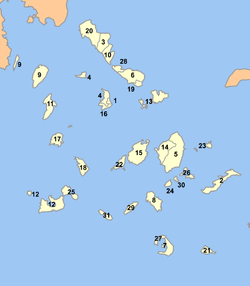CYCLADES
|
Cyclades Νομός Κυκλάδων |
|
|---|---|
| Former prefecture | |
 Location of Cyclades in Greece |
|
 Location of municipalities within Cyclades Prefecture |
|
| Country | Greece |
| Periphery | South Aegean |
| Established | 1833 |
| Disestablished | 2010 |
| Capital | Ermoupoli |
| Subdivisions |
List
|
| Area | |
| • Total | 2,572 km2 (993 sq mi) |
| Area rank | 23rd |
| Population (2005) | |
| • Total | 119,549 |
| • Rank | 29th |
| • Density | 46/km2 (120/sq mi) |
| • Density rank | 34th |
| Postal codes | 84x xx |
| Area codes | 228x0 |
| ISO 3166 code | GR-82 |
The Cyclades (/ˈsɪklədiːz/; Greek: Κυκλάδες, [cikˈlaðes]) are an island group in the Aegean Sea, southeast of mainland Greece and a former administrative prefecture of Greece. They are one of the island groups which constitute the Aegean archipelago. The name refers to the islands around (κυκλάς) the sacred island of Delos. The Cyclades is where the native Greek breed of cat (the Aegean cat) originated.
The significant Late Neolithic and Early Bronze Age Cycladic culture is best known for its schematic, flat idols carved out of the islands' pure white marble centuries before the great Middle Bronze Age Minoan civilization arose in Crete, to the south: these figures have been looted from burials to satisfy a thriving Cycladic antiquities market since the early 20th century.
A distinctive Neolithic culture amalgamating Anatolian and mainland Greek elements arose in the western Aegean before 4000 BCE, based on emmer and wild-type barley, sheep and goats, pigs, and tuna that were apparently speared from small boats (Rutter). Excavated sites include Saliagos and Kephala (on Kea) with signs of copperworking, Each of the small Cycladic islands could support no more than a few thousand people, though Late Cycladic boat models show that fifty oarsmen could be assembled from the scattered communities (Rutter), and when the highly organized palace-culture of Crete arose, the islands faded into insignificance, with the exception of Delos, which retained its archaic reputation as a sanctuary throughout antiquity and until the emergence of Christianity.
...
Wikipedia
